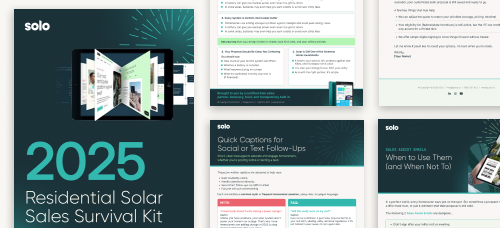H.R. 1, known as the “One Big Beautiful Bill,” has officially passed marking the most substantial shift in U.S. solar policy since the Inflation Reduction Act. The bill introduces critical changes to federal solar tax credits and incentive structures that will affect every part of the residential solar industry: from sales and installation to manufacturing and financing.
While the deadlines just got tighter, the road ahead is clearer. For solar teams ready to act decisively, there’s still time, and plenty of opportunity to stay ahead.
What Changed Under H.R. 1: Key Updates to Federal Solar Tax Credit.
The finalized bill compresses incentive timeline and adds stricter eligibility rules around compliance and supply chains. Here’s a breakdown of what solar teams need to know:
- Residential Clean Energy Credit (§25D):
The full 30% ITC ends December 31, 2025, with no phase-out period. To qualify, homeowners must have their systems installed and reach PTO by that date. - Clean Electricity ITC/PTC (§45Y/§48E):
These credits apply only to projects that start construction within 60 days of the bill’s passage and reach operation by December 31, 2028. Timing and documentation will be critical. - Advanced Manufacturing Production Credit (§45X):
Phases out after 2031. However, any projects linked involving foreign-owned suppliers, especially with Chinese parent companies, may lose eligibility sooner. Supply chain transparency and U.S.-based sourcing will be key to retaining credit eligibility.
How the New Rules Affect Different Segments of the Solar Industry
From sales to manufacturers, these updates touch nearly every part of the residential solar value chain. Here’s how different teams will feel the impact:
Residential Solar Sales and Installation Teams
There’s still a narrow window to act. The 30% tax credit is active through the end of 2025. Teams that can close deals, schedule installs, and reach PTO before the deadline will be in the best position to win homeowner trust and maximize eligibility.
Commercial and Utility-Scale Developers
Project milestones just got more rigid. To qualify §45Y/§48E, developers must break ground within 60 days of enactment and reach completion by 2028. That means faster turnaround on designs, permit readiness, and compliance will be key.
Manufacturers
With the gradual rollback of §45X, manufacturers need to hit financial viability before subsidies drop off. Any exposure to foreign-controlled suppliers could put credits at risk. Now is the time to review and reinforce supply chain transparency.
Lease/PPA Providers
TPO models don’t rely on §25D, which means they’re insulated from the new homeowner deadlines introduced in H.R. 1. As cash and loan buyers rush to qualify before 2025, providers who offer leases or PPAs can offer flexibility, accessibility, and long-term value beyond the credit phaseout.
Six Strategies to Prepare for the End of the 30% ITC
The good news is, there’s still time to adjust with purpose. We’ve pulled together six practical strategies you can use to start adapting today and stay competitive through 2026.
- Educate Homeowners About the 2025 Deadline:
- Launch marketing campaigns that explain the whats at stake, and promote guaranteed install timelines for buyers and reinforce that TPO remains a flexible, no-money-down option.
- Educate Partners on State & Utility Incentives:
- Produce a state-by-state cheat-sheet (focus on CA, IL, MA, NJ) to soften the blow of lost federal support.
- Shift Sales Messaging Toward Total Cost of Ownership
- Emphasize the long-term value of solar, not just tax credit ROI, especially in states where energy costs remain high.
- Conduct a Supply Chain Audit:
- Ensure suppliers meet §45X, §45Y, and §48E compliance
- Update Proposal Tools and Pricing Templates:
- Include toggles for pre- and post-ITC pricing scenarios.
- Strengthen Local Incentive Knowledge:
- Develop quick-reference guides for high-value markets.
What’s Next for Solar Companies After H.R. 1?
While H.R. 1 shortens the incentive timeline, it also provides clarity that solar teams can use to plan ahead. Those who adapt early, communicate clearly with homeowners, and implement compliance-ready processes will have a competitive edge.
Solo is here to support solar teams through this transition. Our platform delivers accurate, verified system design and fast, compliant proposals that help you close deals with confidence.
Need help adapting your proposals or sales strategy?
Book a demo or check out our Getting Started Guide in the Solo Help Center to see what a Solo partnership looks like for your team.
Frequently Asked Questions
What is the deadline for the 30% solar tax credit under H.R. 1?
The 30% federal Investment Tax Credit (ITC) under §25D expires on December 31, 2025. Homeowners must have their systems installed and operational (PTO) by that date to qualify.
Is there a phase-out period for the ITC?
No. H.R. 1 eliminates any phase-out. The full 30% credit ends abruptly at the end of 2025.
How does H.R. 1 impact commercial solar developers?
Projects must begin construction within 60 days of H.R. 1’s enactment and be operational by the end of 2028 to qualify for §45Y or §48E credits. Timely documentation and execution are critical.
Will third-party ownership models still qualify for tax incentives?
Yes. TPO models typically use §48, not §25D, so they’re not directly impacted by the new homeowner-facing credit expiration. That makes leases and PPAs an increasingly attractive path for customers who want to go solar after 2025. TPO providers should continue refining how they structure deals and communicate value.
How does the bill affect solar supply chains?
Any involvement with foreign entities, particularly those with Chinese ownership, may disqualify a project from §45X or §45Y credits. Solar companies must audit their suppliers for compliance.
What can solar companies do to prepare?
Companies should educate homeowners, accelerate late-stage projects, reframe sales messaging, update pricing tools, and audit supply chains. Solo provides tools and services to support these efforts.


